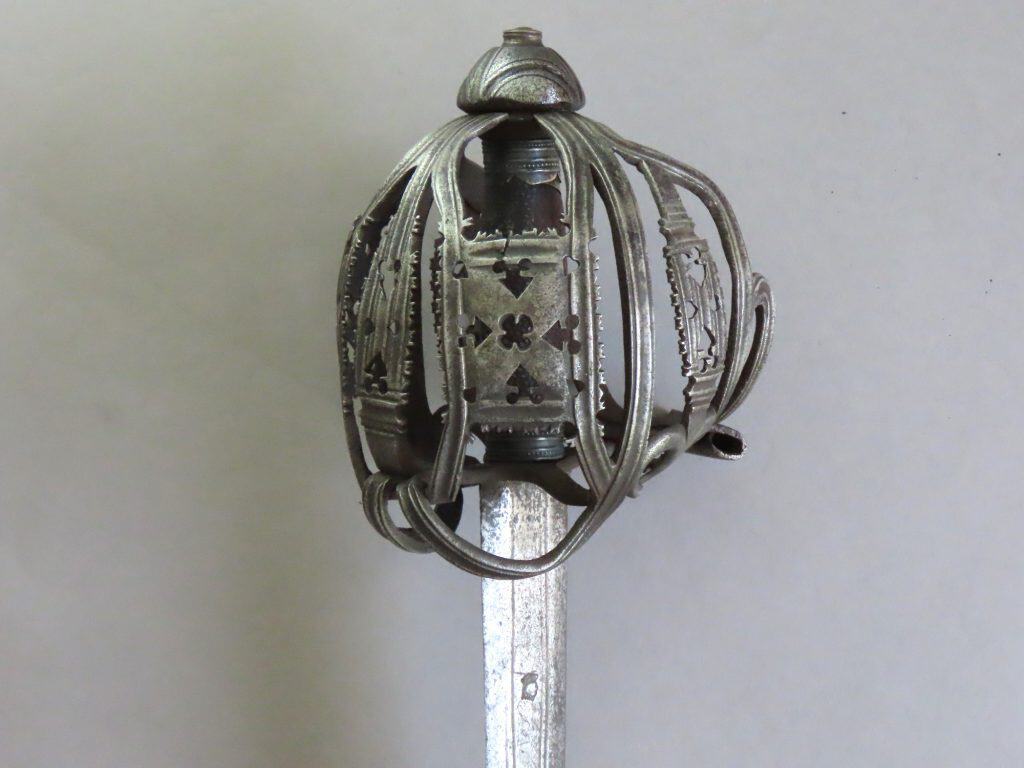
A Scottish Basket Hilted Sword in the “Glasgow Style” dating to the Early 18th century probably made by John Simpson of Glasgow
To enquire about this itemplease click here
Price: £6,750
Ref: 073.23
Item Description
A well balanced sword of fine quality workmanship made in the early 18th century. The main structural bars of the guard are of thick flattened rectangular section. These are decorated on the outside with incised longitudinal grooves along the middle, with a narrower groove on each side, in what has come to be known as the “Glasgow Style”. The sword is mounted with a fine quality broad double edged blade struck with Kings Head armourer’s marks.
The hilt is not struck with any maker’s marks. Due to its similarity with other signed hilts, the maker was probably the second John Simpson, who was admitted Freeman of the Incorporation of Hammermen in Glasgow in 1711, and after which he was entitled to produce swords in his own name. He was dead by 1749. Simpson made swords for the Highland Clans and for the government. During his working life he witnessed the decline of traditional Highland society until its final collapse after the last Jacobite Rebellion in 1745/6. His father, the first John Simpson, held the position of King’s Armourer in Glasgow from the late 17th century until his death in 1717. Both men made swords in similar style during the overlap of their careers. It is therefore possible that the sword was made by the first John Simpson before 1717.
Simpson (I) was succeeded by Thomas Gemmill to the position of Kings Armourer in Glasgow in 1718 who remained in the post until his death sometime before 1730. The position of prestige that John Simpson (II) enjoyed in Glasgow, as the preeminent sword maker in the town, was further enhanced when he succeeded Gemmill to the post of King’s Armourer in Glasgow.
The style of decoration was developed by sword makers in Glasgow towards the end of the 17th century and continued until the third quarter of the 18th century. The style was copied by the most skilled smiths in other sword making centres in Scotland and was also adopted for the British military by the Birmingham based Ordnance manufacturers such as Harvey towards the mid-18th century.
The sword is of fine quality and reminiscent of the quality produced by the best known Glasgow armourers there such as John Simpson (I) and (II) and Thomas Gemmill. For similar examples see Cyril Mazansky, “British Basket-Hilted Swords”, The Boydell Press, 2005.
The Glasgow style of hilt decoration is distinctive. Filing and incising the bars in this manner is a time consuming and skilled task demanding many hours of work and reserved only for the best and most expensive hilts. The pommel has a ribbed button on top from which three sets of triple grooves radiate identical in form to those which decorate the main guard bars. Further decoration in the same manner formed as crescents decorate the spaces between. The guard arm terminals tuck securely into a groove cut around the lower part of the pommel.
The basket hilt of the sword has been intentionally forged to appear slightly asymmetrical when viewed from the front with the basket appearing slightly swollen to the right compared to the left. This is another mark of quality indicating that the hilt was made for a right hand user. The swollen side of the hilt accommodates the fingers of the right hand whereas the opposite side needs only to accommodate the thumb which takes up less space inside the hilt. The grip is formed with a spirally grooved wooden core covered with shagreen and bound with silver wire. Ribbed silver ferrules are mounted onto the grip top and bottom.
The late 17th century double edged blade has a short ricasso from which it is of lenticular section and tapers gently to its tip. Three Kings Head marks extend along the middle of the blade on each side from the hilt flanked by pairs of incised lines. Upon termination of these lines three further Kings Heads form a trefoil on each side. The blade is 32.75 inches long (83 cm) and overall the sword is 39 inches long (99 cm). The sword is in good firm condition.











